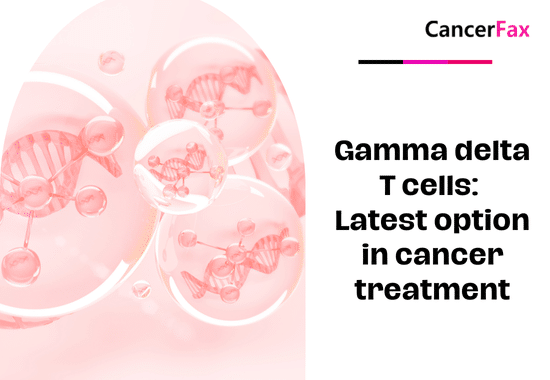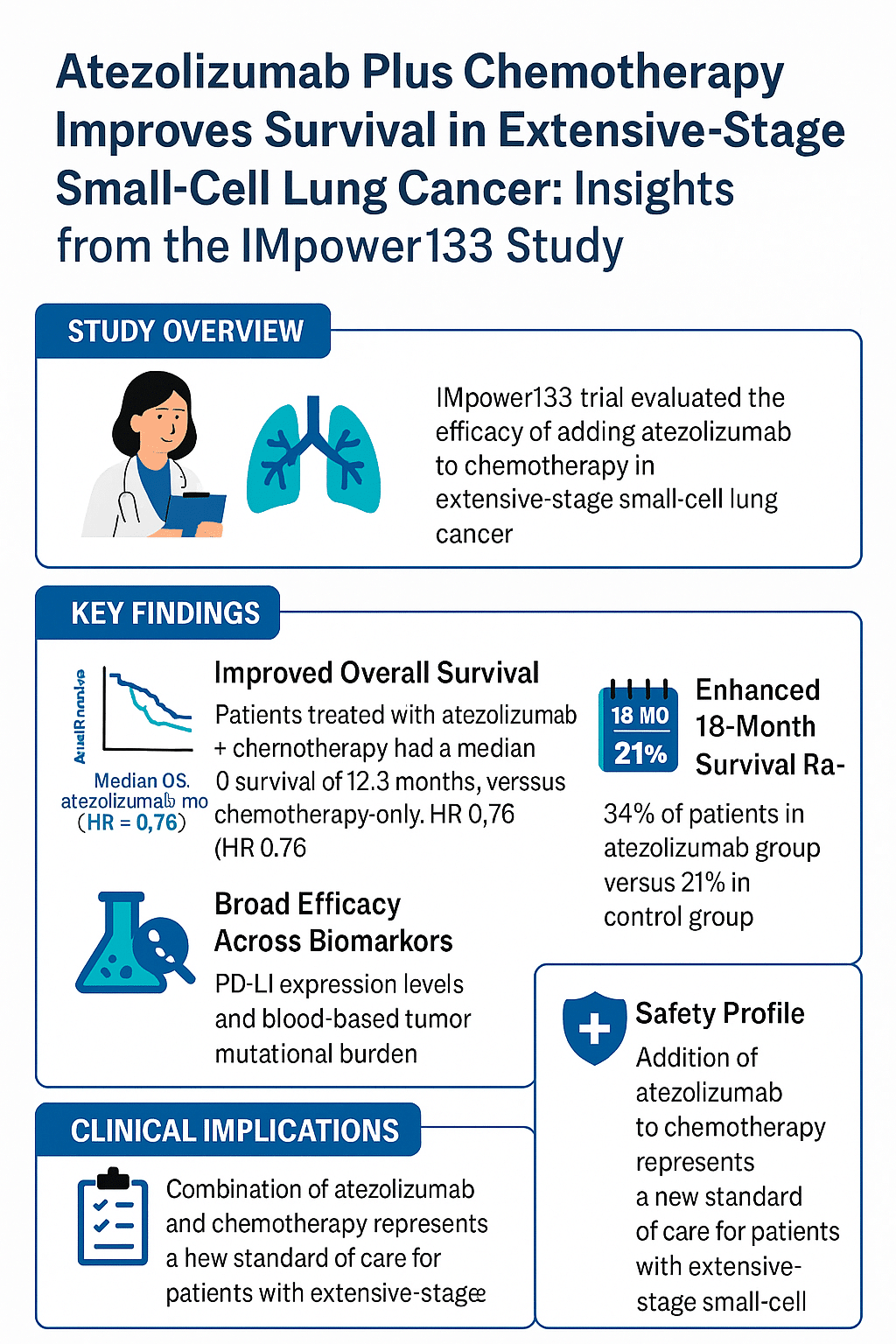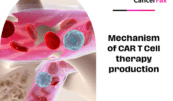Gamma delta T cells: Latest option in cancer treatment
Two types of T-cells
There exist two distinct categories of T cells: αβ T cells and γδ T cells. The previous statement describes a T-cell receptor (TCR) that consists of a heterodimer composed of α and β chains. The latter refers to a T cell receptor (TCR) that consists of a heterodimer composed of γ and δ chains. These chains often do not have the co-receptors CD4 and CD8. On average, they make up around 4% of T cells found in human peripheral blood. γδ T cells serve as a connection between the innate and adaptive immune responses.
When discussing γδ T cells, it is important to recognize that they are not a uniform population, but rather a varied group of cells with different characteristics. Human γδ T cells can be classified into two main groups, Vδ2 T cells and non-Vδ2 T cells, based on the expression of the TCR δ chain variable gene. The bulk of non-Vδ2 T cells are made up of γδ T cells that express Vδ1 and Vδ3.
There is a significant variation in the distribution and occurrence of the γδ T cell subset between different tissues and the bloodstream. Non-Vγ9Vδ2 T cells are now recognized as the primary subset of γδ T cells in various organs and lymphoid tissues, including the skin, colon, lungs, liver, lymph nodes, and thymus. These cells are believed to be adaptive-like γδ T cells.
The Vδ2 chain coupled with a Vγ9 chain is expressed in roughly 50% to 95% of γδ T cells in human blood. Vγ9Vδ2 T cells, a particular fraction, have the ability to universally detect phosphoantigens (PAgs) originating from microorganisms or altered cells through butyrophilin (BTN) family members BTN2A1 and BTN3A1. This recognition occurs via semi-invariant polyclonal expansion, making Vγ9Vδ2 T cells innate-like γδ T cells.
Gamma delta (γδ) T cells
In the last 25 years, T-cell treatments have made substantial progress in the treatment of cancer. While much attention has been focused on chimeric antigen receptor T (CAR-T) cells and other cell treatments utilizing alpha beta (αβ) T cells, the gamma delta T (γδ T) cell subset also shows great potential in fighting cancer. Significant progress has been achieved in preclinical research on γδ T cells since their discovery in the 1980s. Several businesses, such as IN8bio, are now conducting or approaching clinical trials for different types of cancer using γδ T-cell treatments.
γδ T cells possess distinct functional and therapeutic characteristics that set them apart from their more familiar αβ T cell counterparts, making them prospective candidates for cancer treatment. In this article, we provide a more detailed explanation of γδ T cells as a promising approach for cancer cell treatment, focusing on preclinical research.
γδ T cells are differentiated from αβ T cells based on the distinctiveness and composition of their T-cell receptors (TCR). γε T cells have TCRs that do not change. They have one gamma chain and one delta chain, which are made by the TCRG and TCRD genes, respectively. In contrast, αβ T cells have TCRs composed of alpha and beta chains encoded by the TCRA and TRCB genes. γδ T cells constitute a lesser proportion (2-10 percent) of lymphocytes compared to αβ T cells (about 70 percent). This initially led researchers to infer that γδ T cells were akin to αβ T cells but less significant in terms of their roles.
Contrary to the previous notion, numerous investigations have demonstrated that γδ T cells are highly potent elements of the immune system that occupy a crucial position between innate and adaptive immunity. The range is from 2 to 5. Like other cells of the innate immune system, γδ T cells are a component of the initial defense against pathogens. They possess the ability to differentiate between cells that pose a threat due to illness or stress, and cells that are in a normal and healthy state.
The numbers 2 and 3. Unlike αβ T cells, which are activated through the presentation of antigens to their TCRs, γδ T cells can become activated without the need for antigen presentation. Instead, a complex group of other receptors, like the natural killer receptor NKG2D, set off these receptors. These other receptors react to certain chemicals released by cells that are stressed, infected, or changed.
γδ T cells have the ability to function as professional antigen-presenting cells (APCs) in addition to their involvement in innate immunity. They can induce dendritic cell (DC) maturation, stimulate B-cell and natural killer (NK) cell responses, and contribute to other elements of adaptive immunity. γδ T cells might be conceptualized as commanders who first react to a danger (innate immunity) and subsequently organize the activities of the entire armed forces (adaptive immunity). Only a limited number of such generals are required, which could clarify why these potent cells are found in relatively low quantities compared to αβ T cells.
γδ T cells are a very strong defender against cancer
Dr. Lawrence Lamb, IN8bio’s scientific founder and Chief Scientific Officer, conducted groundbreaking research in the mid-1990s that revealed the crucial involvement of γδ T cells in cancer. He demonstrated, for the first time, that pediatric leukemia patients who had undergone bone marrow transplantation (BMT) and had high levels of γδ T cells had better chances of survival.
Four The significance of γδ T cells as primary defenders against cancer has been further demonstrated by experiments in which animals lacking the murine equivalent of γδ T cells formed tumors spontaneously. These data indicate that the absence of surveillance by γδ T cells might lead to a significantly higher incidence of tumors in patients.
γδ T cells are particularly appealing as cancer therapies because they are stimulated by stress signals produced by tumor cells, rather than a singular, specific antigen on a particular tissue type. Consequently, γδ T cells exhibit minimal or negligible toxicity towards healthy cells that might also exhibit the same antigens as cancer cells.
As a result, γδ T cells have a broader therapeutic range and possible safety benefit compared to traditional CAR T cells, which can unintentionally destroy both cancerous and healthy cells that display the CAR’s target antigen. γδ T cells have the potential to be successful against all types of cancer because to their shared characteristic of cellular stress. Additionally, they may exhibit greater potency and toxicity towards certain types of cancer, such as glioblastoma multiforme (GBM).

Preclinical investigations have examined different approaches to changing γδ T cells in order to augment their usefulness and efficacy as treatments for cancer. These strategies involve modifying the cells to produce cytokines that enhance their maturation and differentiation. Additionally, drug-resistant γδ T cells can be engineered and used in combination with chemotherapies to selectively target cancer cells without depleting the overall T-cell population.
Additional alterations involve transducing γδ T cells with a traditional chimeric antigen receptor (CAR) to boost their response against tumors. Alternatively, as demonstrated by IN8bio, γδ T cells can be modified with a non-signaling CAR (nsCAR) that binds to its target antigen without activating the T cells. This modification allows the γδ T cells to adhere to target cells, but they will only eliminate cancer cells that release stress ligands.
In addition to therapeutic uses, ongoing preclinical studies are currently prioritizing the comprehensive comprehension of the characteristics and role of the intricate array of receptors expressed by γδ T cells, as well as the detailed analysis of the distinctions between γδ and αβ T cells. For instance, a published study revealed that PD-1, which is a recognized indicator of fatigue on αβ T cells, paradoxically serves as an indicator of activation on γδ T cells.7 These findings emphasize the distinctiveness of γδ T cells and the extent of our remaining knowledge about them.
With the advancement of the oncology sector towards cell therapy, we are enthusiastic about the potential of γδ T cell therapy to become essential elements of the anti-cancer arsenal. Thanks to the dedication of enthusiastic researchers, whose studies before clinical trials provide valuable insights for the development programs at IN8bio and other companies, and investors who are starting to acknowledge the unique characteristics and potential of γδ T cells, these cells are on the verge of revolutionizing T-cell therapies for cancer treatment.
Future direction
This article provides a thorough examination of the potential uses of γδ T cells in malignant conditions. However, it is important to acknowledge certain constraints and restrictions. Initially, we exclusively utilized PubMed and ClinicalTrials.gov as our main search databases. The clinical trial registration websites in the EU, Japan, China, Australia, and New Zealand were not cross-checked for current trials. Nevertheless, the examined trials should offer a comprehensive summary of the latest advancements in γδ T-cell immunotherapy.
Furthermore, the objective of the analysis on existing γδ T-cell treatment outcomes was to gain a comprehensive understanding of whether the utilization of various treatment approaches could impact outcomes, taking into account the small sample sizes and varied settings of the studies.
For example, we have broadly categorized the therapeutic techniques into three groups, including in vivo stimulation, ACT, and ACT+. However, subsequent research have attempted to integrate in vivo stimulation with other treatments, such as checkpoint inhibitor therapy. Furthermore, the ACT+ group incorporated the alteration of T cells, aiming to limit the ACT group to primarily conventional γδ T-cell infusion. The accuracy of such comparisons will improve as the utilization of γδ T-cell treatments expands in medical clinics in the future.
Notwithstanding these constraints, an examination of previous γδ T-cell immunotherapies allows for the formulation of some definitive findings. Firstly, it should be noted that γδ T-cell immunotherapy is a secure method used in medical settings, regardless of whether it entails in vivo stimulation, reinfusion, or autologous or allogeneic reinfusion. However, this specific study does not delve into this topic.
Typically, adverse effects that were more severe than grade 2 were not directly caused by γδ T-cell therapy and could be effectively managed. Furthermore, it seems that the chosen treatment approach has a substantial influence on the results. The reinfusion of γδ T cells showed a higher likelihood of achieving full responses compared to in vivo activation.
Even in cases where the ACT treatment was not as successful, one out of the two patients who got an objective response had a complete response. Additionally, the ACT treatment had the highest percentage of stable disease when the results were combined. This could be associated with the patient’s reaction to zoledronate therapy. A zoledronate sensitivity test was commonly used in several in vivo stimulation investigations to select participants.
While patients initially showed a positive response to zoledronate, the effect was diminished after numerous treatments. This scenario can be prevented by utilizing multi-reinfusion of active γδ T cells, particularly those derived from allogeneic sources. Furthermore, when it comes to reinfusion, it is worth noting that allogeneic γδ T cells obtained from healthy donors may exhibit greater resilience in the presence of the tumor environment.
Moreover, the integration of γδ T-cell therapy with other established treatments or in vivo stimulation demonstrated encouraging outcomes. Research has demonstrated the stimulating and immune-modulating effects of radiation. The combined therapy activates the tumor microenvironment, which enables the reinfused effector γδ T cells to effectively function within the tumor.
Contrary to CAR-T-cell treatment, γδ T-cell therapy typically requires numerous infusions. The relationship between infusion intervals and dosages and therapeutic responses was not necessarily beneficial. Male patients received higher reinfusion dosages compared to female patients. Furthermore, it is worth mentioning the regional disparity.
This can be attributed mostly to the application of γδ T-cell therapy, as initial research commonly employed the direct stimulation approach. Therefore, the majority of stimulation experiments conducted within a living organism were reported from European countries, while investigations involving the reintroduction of substances were more frequently conducted in Asian countries. It would be intriguing to see whether various therapies yield similar results in different countries in the future.
The results of prognostic studies clearly demonstrate that the functional status of γδ T cells is crucial in the treatment of cancer. The disparity in prognoses, which are dependent on the role of γδ T cells in acute and chronic hematological malignancies, underscores the significance of modulating the functional status of γδ T cells in the development of future immunotherapy strategies. Chronic illness environments appear to foster the growth of defective γδ T cells and favor the selection of the subset that promotes tumor growth.
Hence, the infusion of γδ T cells that are both fully functional and resistant to the tumor microenvironment (TME) could effectively regulate the advancement of cancer. Furthermore, unlike CAR-T-cell or TCR-T-cell immunotherapies, traditional γδ T-cell immunotherapy regimens typically omit the lymphodepletion phase.
Nevertheless, a study revealed that specific chemotherapy medications have the ability to stimulate tumor macrophages and contribute to the development of an anticancer tumor microenvironment (TME). This implies that enhancing treatment regimens could potentially enhance the effectiveness of γδ T-cell immunotherapy.
Moreover, among women receiving solid tumor treatments, the occurrence of objective response (OR) was observed in just three cases (8%), specifically in patients with breast and cervical cancer. Subsequent research could prioritize examining the relative sensitivity of these tumors to γδ T-cell treatment compared to other forms of cancer.
It is crucial to note that breast and gynecological malignancies exhibit the highest occurrence and fatality rates among cancers affecting females, as reported by the Global Cancer Observatory [Global Cancer Observatory (iarc.fr)]. Furthermore, aside from the “quality” of γδ T cells, repeated infusion of abundant natural γδ T cells had a tendency to stabilize the course of the disease.
Unmodified allogeneic γδ T cells, which have advantages that are not dependent on MHC, could be a beneficial treatment option for late-stage cancer patients. This treatment could provide these patients with additional time before enduring further tumor-eliminating treatments.
Furthermore, it is imperative to comprehend the differences between patients who respond and those who do not respond in order to optimize the efficacy of γδ T-cell immunotherapy. Whether the variations are attributed to genetics or microenvironments, this information should improve the comprehension of γδ T cells and empower researchers to make well-informed choices for targeted therapy.
Dr. Nishant Mittal is a highly accomplished researcher with over 13 years of experience in the fields of cardiovascular biology and cancer research. His career is marked by significant contributions to stem cell biology, developmental biology, and innovative research techniques.
Research Highlights
Dr. Mittal's research has focused on several key areas:
1) Cardiovascular Development and Regeneration: He studied coronary vessel development and regeneration using zebrafish models1.
2) Cancer Biology: At Dartmouth College, he developed zebrafish models for studying tumor heterogeneity and clonal evolution in pancreatic cancer.
3) Developmental Biology: His doctoral work at Keio University involved identifying and characterizing medaka fish mutants with cardiovascular defects.
4) Stem Cell Research: He investigated the effects of folic acid on mouse embryonic stem cells and worked on cryopreservation techniques for hematopoietic stem cells.
Publications and Presentations
Dr. Mittal has authored several peer-reviewed publications in reputable journals such as Scientific Reports, Cardiovascular Research, and Disease Models & Mechanisms1. He has also presented his research at numerous international conferences, including the Stanford-Weill Cornell Cardiovascular Research Symposium and the Weinstein Cardiovascular Development Conference.
In summary, Dr. Nishant Mittal is a dedicated and accomplished researcher with a strong track record in cardiovascular and cancer biology, demonstrating expertise in various model systems and a commitment to advancing scientific knowledge through innovative research approaches.
- Comments Closed
- July 28th, 2024






Alternative to CAR-T therapy, Cancer cellular therapy advances, Gamma Delta clinical trials, Gamma Delta T-cell therapy, Innate immune cell therapy, Next-gen cancer treatment, Solid tumor immunotherapy, γδ T-cell immunotherapy
CancerFax is the most trusted online platform dedicated to connecting individuals facing advanced-stage cancer with groundbreaking cell therapies.
Send your medical reports and get a free analysis.
🌟 Join us in the fight against cancer! 🌟
Привет,
CancerFax — это самая надежная онлайн-платформа, призванная предоставить людям, столкнувшимся с раком на поздних стадиях, доступ к революционным клеточным методам лечения.
Отправьте свои медицинские заключения и получите бесплатный анализ.
🌟 Присоединяйтесь к нам в борьбе с раком! 🌟